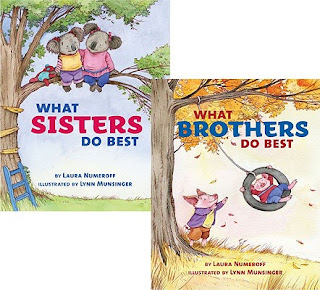Garland, M. How Many Mice? Dutton Juvenile (2007) New York. A division of Penguin Young Readers Group.
ISBN-10: 0525478337
ISBN-13: 978-0525478331
This is by far one of the best number books I have read. The story starts off with ten, their adventure being described about getting food, go home, and eat it. It has a few bumps on the way but at the end, the ten mice are still together and happily enjoyed the food that they collected as a team.
I would use this book for 3-5 years olds because it is an understanding way for children to learn numbers. Different methods can be used to tell this story which makes is simple to work with. It is a happy story with a happy ending, which always makes children feel good! As well, the characters and props in the book would be familiar to children.
The illustrations are made in a way that children can follow along while the story is being read. The illustrations are a mixture of happiness, sadness, horror, and relief. A positive outcome works its way through to the end. Children would enjoy these illustrations because of the variety of colors and textures. They are large enough so that while children are listening, they can contribute by counting in their head or out loud as a group when the educator stops. I was drawn to them because of how cute they are. Really! Everything looks so real and magical.
Provocations:
§ Magnetic board: the board can be empty with two buckets that are filled; one with mice and one with numbers. The mice can match the numbers. For example, the number three in one bucket, and three mice in another laminated together. Children can engage with each other and help each other figure out what goes together.
Present in 3 ways:
§ Felt board- felt pictures with mice, cherries, crows, tomatoes, corn, fish, acorns, fox, carrots, and owl. The entire right amount that is in the book. While the story is being read, either the educator or children can pick the felt out of a box and place it on the board going along with the story.
§ Go on an environment treasure hunt- all of the elements of the story can be hidden except the mice. Ten children can be the mice and will then rotate so all of the children have an opportunity to find the pieces of the story!
§ Pausing in pages of the book, there are questions that connect with the pictures and sentences. Each page can be a pause and a question can be asked. Children can have a chance to observe, connect, and respond to the question with guidance from the illustrations.
Extensions:
§ Children can draw what they imagine their own mice to look like. Then their versions of the mice can be replaced with the ones in the book. As a group, they can create a story with the new mice and as a result children can learn the concept of the different development such as shape, size, and color.
§ Create a rhyme or dance to the story. Then children can be the mice each time they say the dance to the rhyme. They can be any type of mice. This can encourage children with their imagination and the development of cognition with others.
§ With the children’s previous design of the mice, masks can be created. They can be acted out in which are incorporated to the story. The educator can be the sidekick if the child pleases. Children will understand that everyone is different, even mice.











